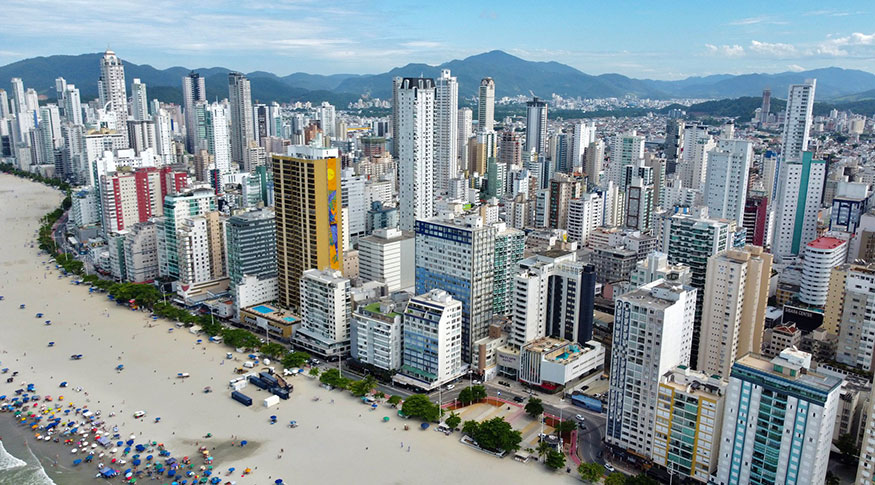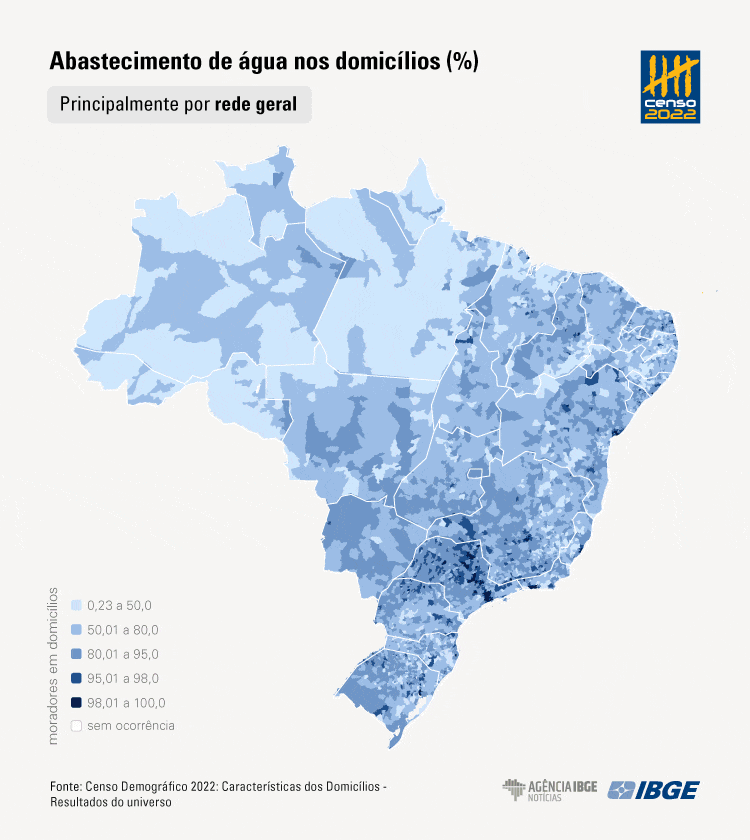2022 Census
2022 Census: Around eight out of every ten persons lived in houses, but the proportion of persons living in apartments is growing
February 23, 2024 10h00 AM | Last Updated: February 27, 2024 10h23 AM
Highlights
- In 2022, 171.3 million persons (84.8%) lived in houses;
- However, the proportion of persons living in apartments has been growing: In 2000, it was 7.6%, rising to 8.5% in 2010 to reach 12.5% registered in 2022;
- Piauí has the highest proportion of persons in houses; Federal District leads in apartments;
- Santos (SP), Balneário Camboriú (SC) and São Caetano do Sul (SP) are the only municipalities among all 5,570 with a predominance of apartment residents;
- In 2022, the general water distribution network was the main form of water supply for 82.9% of the inhabitants;
- 2022 Census also shows regional differences in the form of water supply: while in the Southeast the percentage of residents with a general network was 91.0%, in the North it was 55.7%, and in the Northeast, 76.3%.
- The Northeast had the highest proportions of the "water tanker truck" form of supply (3.5%), which means it was the main form of supply, predominant in 68 municipalities in the Region.
- The North was the Region with the highest proportions of the population using, mainly, deep or artesian wells (24.3%) and shallow or phreatic wells (11.8%).

In 2022, there were 59.6 million occupied housing units in the country, in which 171.3 million persons lived. In other words, the majority of the population (84.8%) lived in this type of residence. The second most common type found was apartments, a housing unit category in which 12.5% of the population lived.
These pieces of information were published today (23) by the IBGE in the release “2022 Census: Characteristics of Housing Units - Results from the universe”. The release event, in partnership with Diadema City Hall and the Great ABC Intermunicipal Consortium, takes place today (02/23), at 10 am, at Clara Nunes Theater, located at Rua 300, Graciosa St.
The event will also be broadcast live by Digital IBGE, and posted on the Institute’s social media (YouTube, Instagram, Facebook and TikTok). You can also read the news about the existence of bathrooms and toilets, types of sewage systems and waste disposal in the 2022 Population Census.
Housing units of the “closed street or condominium house” type, which in 2010 housed 1.6% of persons residing in Brazil, now house 2.4% in 2022. Thus, together, the types “house” and “closed street or condominium houses” brought together 87.2% of the population.
The broad predominance of houses among the types of housing units had already been recorded in previous Population Censuses, as well as the tendency for the proportion of apartments to increase: in 2000, 7.6% of the population lived in this type of housing unit, a number that rose to 8 .5% in 2010 to reach 12.5% registered in 2022.
Bruno Perez, survey analyst, explains that this increase is significant and national, being registered in all the Major Regions of the country, although it is more typical of big urban centers. “This verticalization is a response to the population density in municipalities, mainly in Metropolitan Areas and in the centers of bigger cities,” he states.

The remaining categories are residual. A group of 494 thousand persons (0.2% of the population) lived in housing units of the “boarding house or tenement” type. The other two categories housed less than 0.1% of the population: “Indigenous housing without walls or maloca”, with 52 thousand persons, and “degraded or unfinished permanent residential structure”, with 81 thousand persons.
Piauí has the highest proportion of persons in houses; Federal District leads in apartments
Comparing the 2010 Census with the 2022 Census, the proportion of the population living in an apartment increased in all Major Regions. The highest percentage is in the Southeast (16.7%), followed by the South (14.4%). The North records the lowest figure (5.2%).
Among the Federation Units (UF), Piauí had the highest proportion of the population residing in housing units classified as "houses" (95.6%), closely followed by Tocantins (95.3%) and Maranhão (95.1% ). The lowest was in the Federal District (66.14%), which in turn, led the ranking of percentage of the population residing in apartments (28.7%), while Tocantins (2.5%) had the lowest proportion in this matter.
The highest occurrence of houses in a closed street or in a condominium was recorded in Rio de Janeiro (5.9%), followed by Roraima (5.3%). Espírito Santo (0.5%) had the lowest percentage.
Santos (SP), Balneário Camboriú (SC) and São Caetano do Sul (SP) are the only municipalities with a predominance of apartment dwellers
Despite registering an expansion of apartment-type housing units, the 2022 Population Census shows that, of the 5,570 Brazilian municipalities, this modality predominated in only three. They are national exceptions, but with peculiar and different characteristics. One of these municipalities is Santos (SP), the only one on the list in the 2010 Census, when 57.8% of the population lived in apartments. This percentage increased to 63.4% in 2022. “It is a municipality with a large part of its area on an island, where the urban part is already fully occupied. Therefore, the expansion trend is verticalization. Part of what could be the outskirts and less dense regions of Santos are in neighboring municipalities”, explains Mr. Perez.
Balneário Camboriú (SC) follows a different dynamic. With intense real estate activity in recent years and being an important tourist destination in the South region, the municipality of Santa Catarina saw the percentage of residents in apartments jump from 48.9% to 57.2% from the 2010 Census to the 2022 Census. The north coast of Santa Catarina has attracted attention due to the large number of skyscrapers built recently. "It's a trend in high-valued coastal areas: a densification that generates verticalization to attract more people who want to be close to the beaches", explains the researcher.
São Caetano do Sul (SP) completes the list. The municipality, says Mr. Perez, has a relatively small area, with a medium-sized population and is very much part of the Metropolitan Area of São Paulo, being considerably close to downtown. “In other words, it has similar characteristics to the area of the so-called Expanded Center of São Paulo: very dense and has considerable verticalization”, adds the analyst.
Municipalities with the highest percentage of apartments
| # | Municipality | (%) |
|---|---|---|
| 1 | Santos (SP) | 63.45 |
| 2 | Balneário Camboriú (SC) | 57.22 |
| 3 | São Caetano do Sul (SP) | 50.77 |
| 4 | Vitória (ES) | 45.4 |
| 5 | Porto Alegre (RS) | 42.36 |
| 6 | Viçosa (MG) | 41.68 |
| 7 | São José (SC) | 41.05 |
| 8 | Niterói (RJ) | 40.2 |
| 9 | Itapema (SC) | 38.76 |
| 10 | Florianópolis (SC) | 38.64 |
In 2022, general water distribution network was the main form of water supply for 82.9% of residents
Today's release of the 2022 Census also presents results regarding the main form of water supply to housing units in Brazil. The general distribution network appeared in 60.8 million housing units, where 167.5 million persons (82.9%) lived. This percentage is higher than the occurrence of the option recorded in the 2010 Population Census (81.5%), despite changes made to the questionnaire to make the classification stricter.
Deep or artesian wells were the second main form of supply, appearing in housing units representing 9.0% of the population. Next, shallow wells (3.2%) appears, a source or spring (1.9%).
Together, these four forms, considered adequate for monitoring purposes of the National Basic Sanitation Plan (PLANSAB), served 96.9% of the population in 2022.
With a lower national occurrence are water tanker trucks (1.0%), rivers, dams, brooks, lakes and streams (0.9%), and stored rainwater (0.5%). A set of 0.6% of the population mainly used forms of supply that did not fit into the options in the questionnaire.
2022 Census: regional differences in water supply
The general network was the main form of water supply in all regions, but with unequal proportions. While in the Southeast the percentage was 91.0%, in the North it was 55.7%, and in the Northeast, 76.3%. The North, in fact, was the region with the highest proportions of the population using, mainly, deep or artesian wells (24.3%) and shallow or phreatic wells (11.8%).
The Northeast had the highest proportions of the "water tanker" (3.5%) and "stored rainwater" (1.8%) forms of supply, while the North Region had the highest proportion of the "Rivers, dams, brooks, lakes and streams” (5.3%). Among the UFs, only São Paulo (95.6%) and the Federal District (92.8%) had more than 90% of residents in housing units with a general water supply network as their main supply form. On the other hand, Pará (48%), Rondônia (45.3%) and Amapá (43.7%) did not reach 50%.
“Among the municipalities”, highlights Mr. Perez, “there are regional peculiarities that significantly change the logic of water supply service”. In 4,753 municipalities, 50% or more of the population was supplied mainly by the general network and in 5,157 municipalities the general network was the predominant form of water supply. However, one of the regional peculiarities pointed out by the researcher is in the “water tanker” aspect. Despite its low national participation, in 2022, it was the predominant form of supply in 68 Brazilian municipalities, all located in the Northeast.

The 2022 Census also recorded that in 69.3 million housiing units, in which 192.3 million persons lived (95.1%), water was piped into the residence. For 2.5% of the population, water was piped, but only up to the ground. For another 2.4%, water was not piped.
In the comparison between the Major Regions, the South had the highest rates of residents with piped water (99.4% into the residence and 0.3% onto the ground), while the North had the lowest rates (87.1% and 6.4%, respectively), also presenting the highest rate of housing units without piped water (6.4%)
Paraná, São Paulo, Espírito Santo, Santa Catarina, Rio Grande do Sul and the Federal District were the states that had more than 99% of residents with piped water to their homes. Amazonas (9.6%), Acre 9.6%) and Pernambuco (9.2%) were the states with the most residents without piped water
More about the survey
The 2022 Population Census: Characteristics of housing units - Results from the universe brings information regarding the form of water supply, disposal of waste, type of sewage system, existence of a bathroom or toilet and existence of water pipes, allowing a characterization of important elements of the homes and living conditions of the population. Data is available for Brazil, Major Regions, states and municipalities. The pieces of information will also be disaggregated according to color or race and age groups of population. Moreover, data can be viewed on the Interactive Geographic Platform (PGI) and in the 2022 Census overview.



















